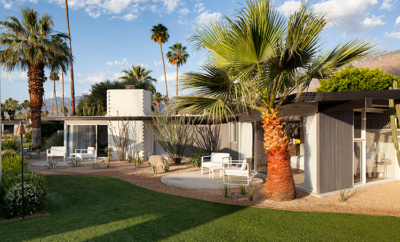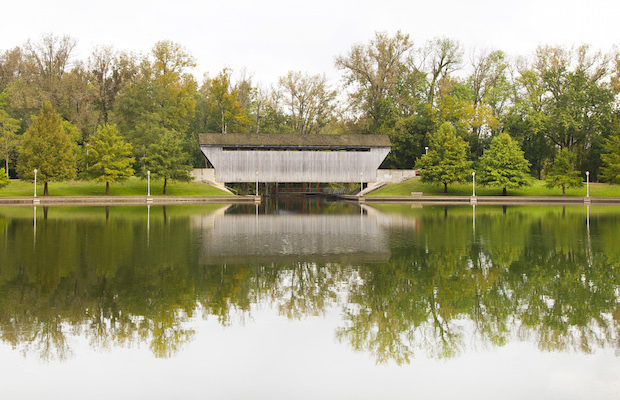 A view of Michael Van Valkenburgh’s Mill Race Park, 1992, featuring the reconstructed 1840 Brownsville Bridge. Hadley Fruits Photo
A view of Michael Van Valkenburgh’s Mill Race Park, 1992, featuring the reconstructed 1840 Brownsville Bridge. Hadley Fruits Photo
Exhibition
It All Makes Sense in Columbus, Indiana
HERE, ON A GRID FOUNDED IN 1821 near the confluence of the Flatrock River and Haw Creek, is a city of some forty-seven thousand Hoosiers. Forged out of railroad spurs and highway jug handles, connecting central Indiana with the rest of the region, Columbus is home to the Cummins Engine Company, long the world’s leading manufacturer of diesel engines. It is a city with a remarkable history as one of the most vital centers of art and architectural patronage in the United States—Lady Bird Johnson famously called it the “Athens of the Prairie.” And today, this legacy still endears the city to discerning aficionados of modern architecture. Happily, it will all be on display with Exhibit Columbus, an “annual exploration of architecture, art, design, and community” that has its inaugural run from August 26 to November 26.
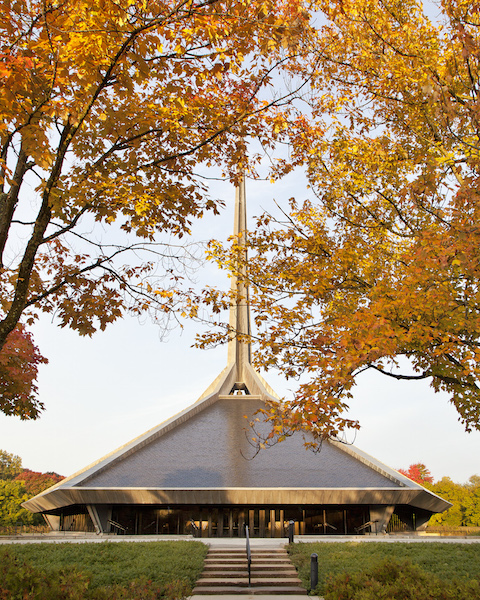
Eero Saarinen’s North Christian Church, 1964. The building’s low-slung hexagonal base rises up as if about to touch the sky. Hadley Fruits Photo
Led by Richard McCoy, the gregarious and ambitious director of Landmark Columbus, Exhibit Columbus was unveiled in May 2016 as a public program to highlight the city’s architectural heritage by emphasizing the importance of community in promoting design excellence. Along with Anne Surak, who runs the arts consulting firm art + space in Indianapolis and serves as director of exhibitions for Exhibit Columbus, McCoy has made great strides in promoting the city’s art and architectural offerings beyond Indiana. This may seem like a tall order, especially since Exhibit Columbus seems worlds away from the now-regular cycle of bi- and triennials in Shanghai, Venice, Chicago, Istanbul, Oslo, and Lisbon. Yet Columbus is a place made extraordinary by virtue of its high concentration of mid-century modern and postmodern architectural masterpieces. One would be hard pressed to think of any other place where schools and civic buildings by the likes of Eero Saarinen, I. M. Pei, Gunnar Birkerts, Harry Weese, Kevin Roche, Robert A. M. Stern, Deborah Berke, and others seem so indelibly woven into the fabric of such a small community.
With Exhibit Columbus, McCoy and Surak are also busy rekindling the work of industrialist and patron J. Irwin Miller (1909–2004), whose energy and vision culminated in the architectural offerings that figure so prominently in Exhibit Columbus. The legacy of the Miller name continues with the J. Irwin and Xenia Miller Prize Competition, Exhibit Columbus’s signature event, which features site-specific installations designed by leading practitioners that share space with the city’s most important modern buildings.
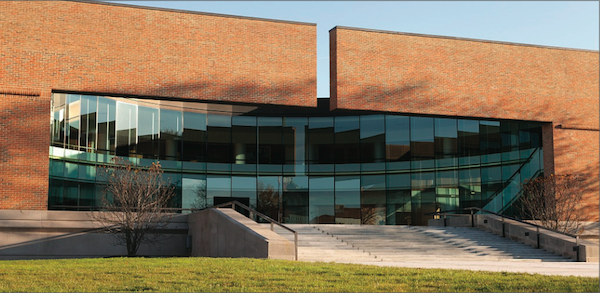
The elegant, abstracted spatial composition of Columbus City Hall, designed by E. Charles Bassett for Skidmore, Owings & Merrill, completed in 1981. Hadley Fruits Photo
A preliminary guide to what will be on display during Exhibit Columbus is the Paul Rand–designed guidebook, Columbus, Indiana: A Look at Architecture. Better yet, drive into the heart of Columbus and park your car close to the intersection of Washington and Fifth Streets, then walk east. In seconds you will encounter the slender bell tower and abstracted forms of Eliel and Eero Saarinen’s First Christian Church (1942), considered the first modern building in Columbus. It stands across Fifth Street from I. M. Pei and Partners’ Bartholomew County Public Library (1969), whose rough brick coursing, alternating deep voids and stout volumes, provides a dramatic backdrop to the grand form of Henry Moore’s Large Arch (1971). Continue walking east, and you will see Gunnar Birkerts’s St. Peter’s Lutheran Church (1988). Notable for its graceful copper-clad spire that appears to rise from a drumlike base, the church stands across Fifth Street from one of Birkerts’s most important projects: Lincoln Elementary School (1967), a brilliantly composed series of alternating circular walls and square spaces, resulting in a building that, as noted in a 1967 issue of Architectural Forum, seems to disappear into the landscape.
There is more, of course. Retrace your steps toward Washington Street and there, on the northeast corner, is Eero Saarinen’s Irwin Union Bank and Trust Building (1954, now the Irwin Conference Center), a pleasing, jewel-like Miesian edifice noted for its nine cupolas and surrounded by one of Dan Kiley’s impeccable landscapes. Farther east, ivied porticoes frame the bold, sawtooth forms of Kevin Roche’s Cummins Corporate Office Building (1984). And beyond this, just a little ways south, is Mill Race Park (1992–1993), one of landscape architect Michael Van Valkenburgh’s career-defining works, which also features folly-like structures by Stanley Saitowitz, as well as a reconstructed nineteenth-century covered bridge. Once you get back in your car, you can book a tour of Saarinen’s house for Irwin Miller (1957), an iconic mid-century home whose pristine open plan and sunken conversation pit in the living room feature textile designs by Alexander Girard.
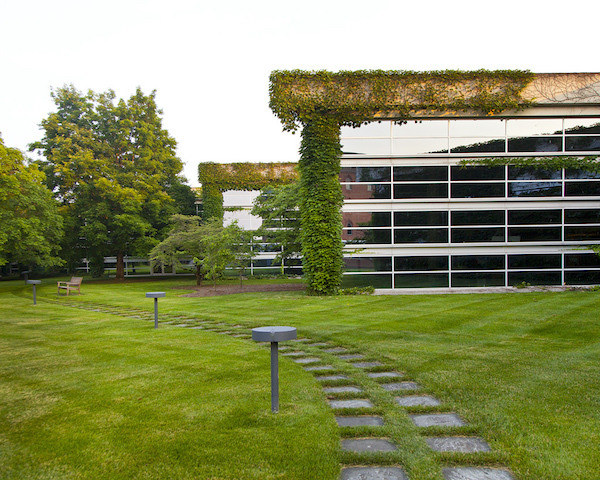
The ivied porticoes of Kevin Roche’s Cummins Corporate Office Building, 1985, frame the structure’s bold sawtooth forms. Hadley Fruits Photo
On my first visit to this Athens of the Prairie, I met with McCoy, who kept insisting that Columbus was different. To prove his point, he took me on a tour of two buildings on opposite sides of the city. First, there was Eero Saarinen’s North Christian Church (1964), a low-slung hexagonal building that appears to rise—from one of Kiley’s typically understated landscape designs—to touch the sky. On the inside, the hexagonal motif appears to withdraw into itself, as pews converge on an altar placed in the middle of the space, affirming the central importance of the congregation. After the church McCoy took me to the other end of town to see Columbus City Hall. Completed in 1981, this building, designed by E. Charles Bassett for Skidmore, Owings & Merrill, appears as an elegant, abstracted spatial composition of an isosceles right triangle and a semicircle. And just inside the entranceway, curved, glazed partitions lead to spacious interior offices. In one, I saw one of Girard’s colorful maquettes for a “model block” along Washington Street. And when walking toward the entrance, I was greeted by Robert Indiana’s pop art idea for the seal of the City of Columbus, which, if you think about it, is really just a highly stylized elevation of Columbus City Hall. McCoy was the first to point out to me how Indiana’s painting incorporates the building’s oversize cantilevers as a framing device. The forms almost seem to touch in midair, hovering above the building’s grand entrance. If there is any kind of built expression for McCoy’s insistence that Exhibit Columbus is to be an annual “exploration of architecture, art, design, and community,” it would be Columbus City Hall—a public building where a pop art painting complements a view of the oldest part of the city.
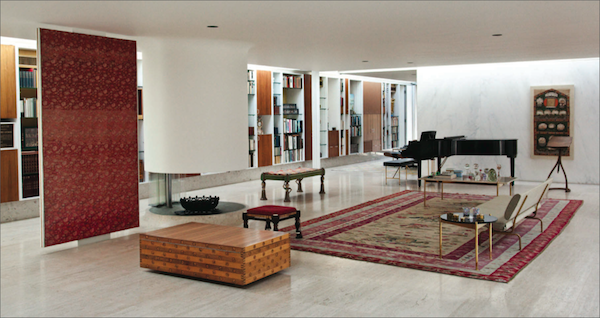
Saarinen’s house for Irwin J. Miller, 1957, is an icon of mid-century design, and features textiles and interiors by designer and architect Alexander Girard. Miller House and Garden, Columbus, Indiana / Photo courtesy Indianapolis Museum of Art
Columbus matters, something made clear by all these buildings. As I returned to my car, I again thought of Saarinen’s soaring spires and Bassett’s hovering cantilevers—two buildings, two radically different conceptions of architectural form and program, each unified by a compelling vision. Perhaps it was architect Deborah Berke who put it best when she recently observed that the architectural master-works in Columbus are not so much the product of great architects as they are the reflection of a great and vital community. One hopes that Exhibit Columbus will be around for a long time so that others can see why this is the case.



